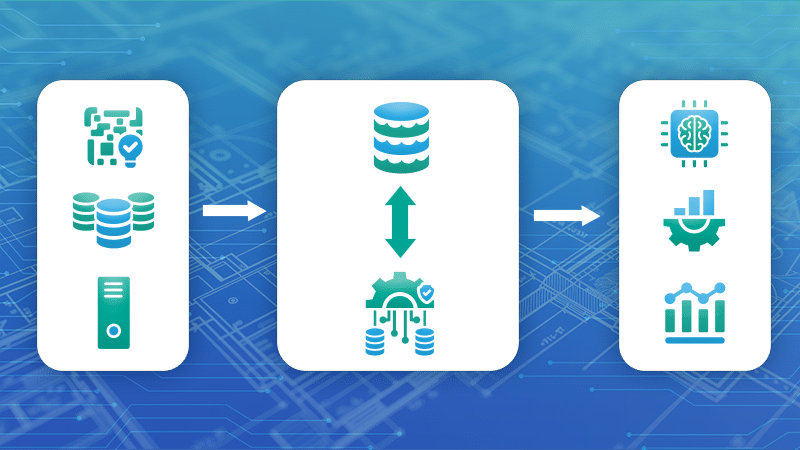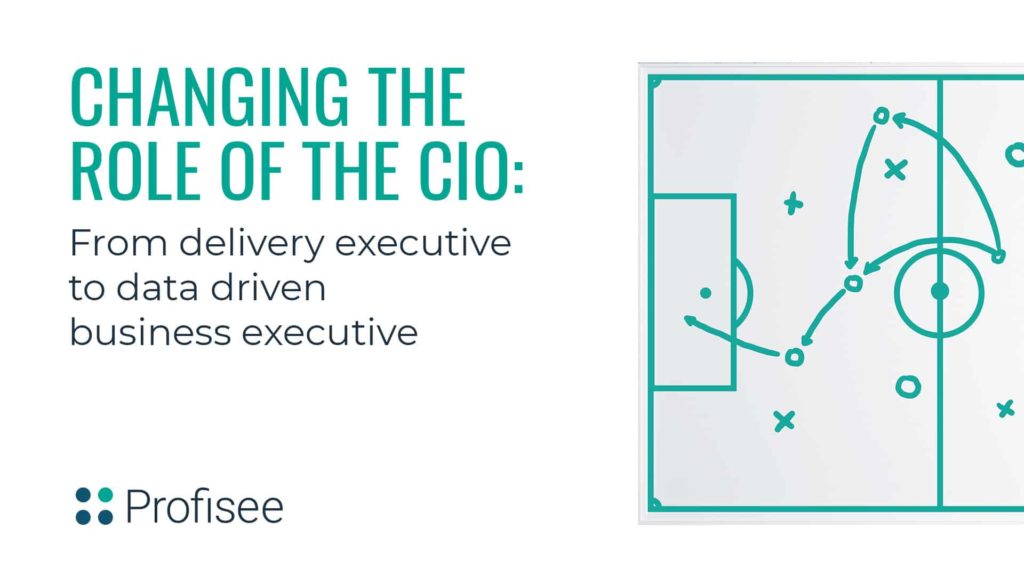Implementing a data strategy is a critical foundation for realizing the transformative power of data within any company. A data strategy is a high-level blueprint that explains why data is critical to the success of a company and how it will optimize the value of data. Defining and implementing a data strategy is a key deliverable of the Chief Data Officer (CDO) or the senior business leader with the accountabilities of a CDO. Like all enabling strategies of an enterprise, a data strategy is a living, breathing document under constant scrutiny and revision based on changing market and business needs.
Given the definition and implementation of a data strategy is something that will happen over an extended period of time, it’s critical for all data leaders responsible for the data strategy to define a roadmap for its implementation.
A data strategy roadmap establishes the high-level priorities of an organization’s data strategy and enables data leaders to appropriately manage the expectations of their business users. All effective data strategies should have both a short- and longer-term horizon — with both phases running in parallel, starting as quickly as possible from the time a CDO assumes the role within the company.
Phases of an MVP Approach to Data Strategy
I strongly recommend taking an MVP approach to defining and implementing your data strategy. This approach will maximize the likelihood that data leaders will deliver value from the strategy in weeks, not months or years.
An MVP approach recognizes that there are many dependencies to successfully implement all aspects of a strategy; however, it requires a limited-scope focus on only those dependencies which are needed to fulfill the successful execution of each initial phase of the strategy.
It also recognizes there are key factors, like the culture of the organization, which the strategy is designed to influence — but where those factors will not be changed in the short term and are subject only to forces that have been consistently reinforced over time through the successful realization of business value.
To help CDOs put their data strategies into action, I’ve broken down this MVP approach into a few discrete phases.
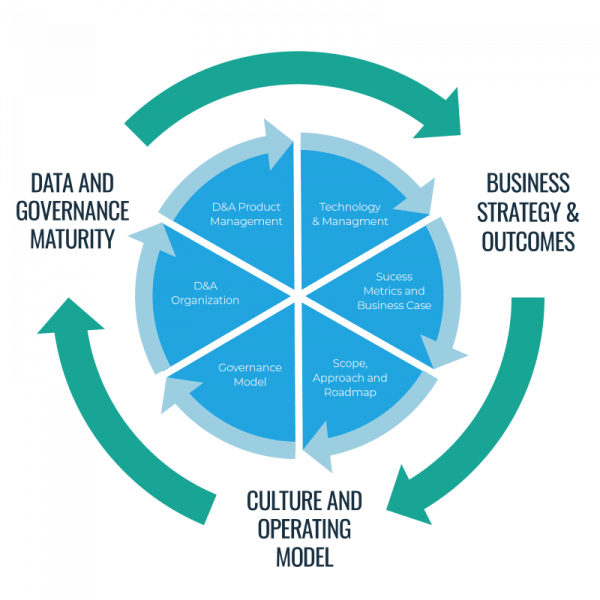
Short Term (Next 4-6 Weeks, Max)
The goal of this phase is to define a high-level data strategy as quickly as possible, fully acknowledging that the output of this phase will most certainly be updated and revised as time progresses.
The three primary outputs of this phase will be:
- A draft data strategy
- A high-level prioritized roadmap
- A draft business plan, including cost/benefit analysis for the program, and each of the initial phases of the roadmap
Together, these three outputs should be considered the full data strategy. However, when considering just the strategy document itself, it’s important to remember that the data strategy defines why data is critical to the business and how the business will operationalize it.
It’s also important to note that each of these outputs needs to be addressed in parallel and cannot be developed in a waterfall fashion. The roadmap is a function of the business value of every item on the roadmap, and the business value is a function of the expected capabilities and practices delivered through the implementation of the strategy and supporting operating model.
A. The Data Strategy Document (Initial Draft)
When documenting a data strategy, CDOs should take the following into consideration:
- The business goals and objectives: the data strategy should fully reflect and support the overall business strategy, and it should articulate why data is a critical enabler of the business strategy. For example, if a company has a strategy of market-differentiating customer service, then managing data relating to customers should also be a top priority. CDOs must understand the key drivers of business success and must be able to articulate how the data function supports those drivers.
- The operating model of the business: the operating model of the data organization should optimally reflect and support the operating model of the business. If the business is highly federated, then implementing a highly centralized operating model within the data team is a recipe for major problems down the road.
- Establishing an appropriate data operating model, enabled by:
- A data architecture: the architecture must be able to support both the short- and longer-term needs as defined within the data strategy.
- A data governance framework: this will outline how a data governance function will be operationalized within the organization. How this framework is implemented over time (see below) will be critical to the success of this strategy.
- A data management and analytics practice (inc. data science): the requirements for enabling the disciplines of data quality, master data management, data integration, BI/analytics, and metadata management, as needed to support the strategy, should be outlined in the document.
- A data product management function: data leaders must consider how they will support the ongoing management of their data products, taking a data product management approach. Therefore, their operating model should consider things like product development, user-centric design, go-to-market (including end user training and enablement), product marketing and product lifecycle management.
- Enabling technologies: the operating model must consider which high level technologies will be required to enable the business goals defined in (i) above.
- A data organization: the operating model must consider the organizational structure of the data and analytics function as well as the required roles and responsibilities to fulfill the stated mission of the team.
- Critical External Dependencies, Risks, and Organizational alignments: the data strategy should outline all of the key dependencies that exist in other areas of the business. For example, if there is a dependency of the strategy on a vendor to implement a certain technology, that dependency should be considered in the roadmap and be documented. The same is true with understanding any major risks, and any alignment needed from key business stakeholders. The strategy, roadmap and supporting business case must be clearly communicated to all key business stakeholders, including all of the C-suite.
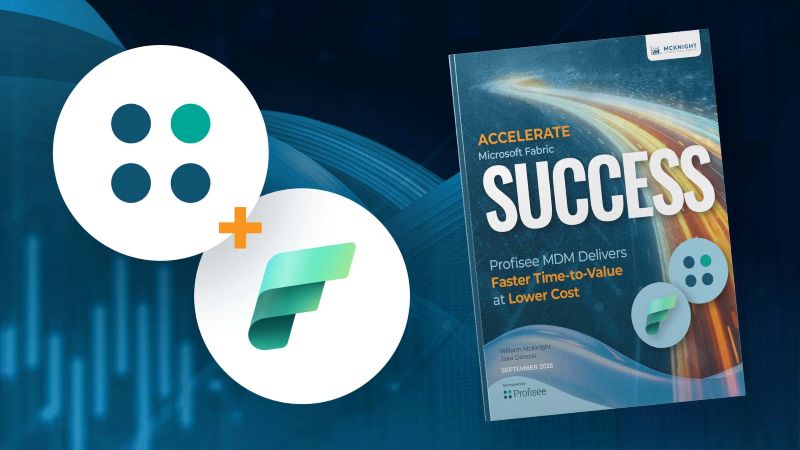
Accelerate Microsoft Fabric Success
B. The Supporting Roadmap (Initial Draft)
A critical element to the success of the data strategy is for data leaders to also have some idea of when and how aspects of the strategy will be implemented and provide value to customers within the business. This requires the creation of a roadmap which outlines the first three to five major deliverables associated with the data strategy.
The best practice in creating this roadmap is to follow agile methodologies, where each phase is considered a minimum viable product (MVP). Each MVP will be the smallest amount of work required to deliver meaningful value, where the choices of which initiative to embark on, and which to prioritize, are a function of the expected business value delivered by each phase.
The MVP approach requires data leaders to implement only those aspects of the data and analytics operating model (see above) needed to successfully deliver each MVP. For example, rather than focusing on defining all aspects of a data governance framework in the short term, only focus on those data governance deliverables needed to successfully launch the next MVP.
Once the initial roadmap is defined, it must be shared with all major stakeholders, where their alignment on the first series of MVP initiatives and their supporting business cases is critical.
C. The Business Case (Initial Draft)
Building a business case is a mission-critical but often overlooked aspect of data strategy. This business case should develop a high-level (and likely imperfect) estimation of the quantified business benefits of investments in data and analytics, in dollar terms.
This business case should span two perspectives: (i) the overall expected benefits from the strategy as a whole, and (ii) the expected benefits from each of the individual MVP initiatives that are planned as a part of executing the data strategy roadmap.
Keep in mind these are all initial estimates and will be continually refined over time as new information is gleaned on the success of the initiatives, opportunities to improve the performance of your estimates and changing market and business dynamics. Collaborating with key stakeholders in finance (particularly financial planning and analysis) will be critical to building a business case that can pass the scrutiny of senior leaders in the C-suite.
DATA INSIGHTS,
DIRECT TO YOUR INBOX
Longer Term (Ongoing)
In the longer term, you need to apply a programmatic focus to your data strategy that treats it as an ongoing initiative, and not a one-and-done. Your approach needs to integrate a consistent and prolonged focus on two parallel actions:
- Regularly updating your data strategy, roadmap and business case based on changing business needs and market dynamics. This will optimally happen on a quarterly basis but no more infrequently than annually.
- Consistently continuing to deliver value through an MVP approach to executing on your strategic deliverables as outlined in the following graphic. The delivery of each MVP will include:
- A monitoring function to ensure that the value realized is (at least) the initial expected value as defined in the supporting business case
- Promotion of your success to the wider organization, where you share the impacts made through the delivery of that MVP. This promotion will be a key responsibility of your product management function.
- Identification of the next MVP. This should be a function of the desired business outcomes, the expected benefits of the MVP, and current market and business dynamics.
- Securing additional funding. If necessary, the success of the previous MVP should be used to secure whatever additional funding is necessary for the next round of MVPs.
Revisiting your D&A operating model on a regular basis, revising it as necessary to stay aligned to changing market dynamics, customer priorities or business priorities.
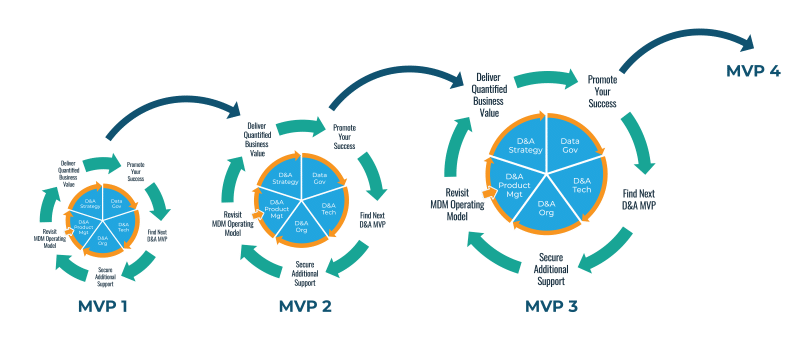
The Benefits of an MVP Approach
Creating a data strategy roadmap is not just an isolated task but an ongoing, dynamic process that requires careful planning, execution and continuous refinement.
By adopting an MVP approach, CDOs can ensure that their data strategies deliver immediate value while also building the foundation for long-term success. This method allows for quick wins and agile adjustments, ensuring that the data strategy remains relevant and aligned with evolving business needs.
To dive deeper into how you can effectively implement and maintain a data strategy in your organization, tune in to the CDO Matters Podcast, where I interview thought leaders and share valuable insights and practical advice for data leaders navigating the complexities of today’s data-driven landscape.
Subscribe to the CDO Matters Podcast

Malcolm Hawker
Malcolm Hawker is a former Gartner analyst and the Chief Data Officer at Profisee. Follow him on LinkedIn.








